calsfoundation@cals.org
Clinton (Van Buren County)
County Seat
| Latitude and Longitude: | 35º35’29″N 092º27’37″W |
| Elevation: | 564 feet |
| Area: | 13.45 square miles (2020 Census) |
| Population: | 2,509 (2020 Census) |
| Incorporation Dates: | January 9, 1851; August 15, 1879 |
Historical Population as per the U.S. Census:
|
1810 |
1820 |
1830 |
1840 |
1850 |
1860 |
1870 |
1880 |
1890 |
1900 |
|
– |
– |
– |
– |
– |
– |
– |
166 |
176 |
297 |
|
1910 |
1920 |
1930 |
1940 |
1950 |
1960 |
1970 |
1980 |
1990 |
2000 |
|
– |
– |
– |
915 |
853 |
744 |
1,029 |
1,284 |
2,213 |
2,283 |
|
2010 |
2020 |
|
|
|
|
|
|
|
|
|
2,602 |
2,509 |
|
|
|
|
|
|
|
Clinton has been the county seat of Van Buren County since 1844. Sheltered in the Little Red River valley, the city has been bypassed by many of the major events of Arkansas’s history, including Civil War battles, the building of the railroads, and the desegregation turmoil of the mid-twentieth century.
Louisiana Purchase through Early Statehood
When the land that would become Arkansas became part of the United States through the Louisiana Purchase in 1803, the Little Red River valley was included in land recognized as Osage hunting territory. The Osage had permanent settlements farther north but frequently visited north-central Arkansas. An 1825 treaty removed the Osage tribe to Kansas, opening the land for settlement by Americans of European descent. Van Buren County was created by the state legislature on November 11, 1833, as a result of the increasing settlement of that part of the state.
George Counts is usually described as the founder of Clinton. A post office was established and named Clinton on December 20, 1833. While it is generally assumed that the settlement was named for New York governor DeWitt Clinton, no record survives to explain why his name was used. The first cotton gin in the county was built in 1840 in Clinton and began operating on Christmas Day, drawing a crowd of about 100 people. The gin, powered by two oxen, was capable of picking the seeds from about 400 pounds of cotton per day. In 1844, the Van Buren county seat was moved from Bloomington to Clinton; the first courthouse built in Clinton was a one-room log structure raised by the men of the community. Clinton was incorporated for the first time on January 9, 1851.
Civil War through Reconstruction
Slavery existed in Van Buren County before the Civil War, but only about 200 slaves were in the county in 1860 out of a total population of 5,357. County citizens were not initially inclined to support secession of Arkansas from the United States. Twenty-seven citizens of the county were arrested for involvement in the Arkansas Peace Society. Taken to Little Rock, they were forced to serve in the Confederate army. No major Civil War engagements happened in the Clinton area. Van Buren County men served in both armies.
The era of Reconstruction after the war did, however, bring changes to the small community. In 1865, the frame courthouse that had replaced the older log structure was burned by bushwhackers. For four years, the county government met in the Methodist church. A new frame courthouse was constructed for $30,000. Lumber for the project came from a sawmill north of town owned by County Judge David Wilson—described as a carpetbagger from Indiana—and by his son-in-law, M. C. Rerdell, who was the sheriff and tax collector of Van Buren County. Meanwhile, the old county courthouse was occupied by an African-American couple, Dave and Cinda Bradley. Cinda Bradley conducted a boarding house that served only white guests, while her husband owned a carriage with four horses, which he used to convey county officials between Clinton and Little Rock (Pulaski County).
Post Reconstruction through the Gilded Age
Evidently, local records of the 1851 incorporation were lost, and the community was incorporated once again on August 15, 1879. (The city even celebrated its centennial anniversary in 1979, based upon this date.) Also in 1879, Clinton’s first high school opened under the name of Clinton Male and Female Academy. A steam-powered mill, grinding both corn and wheat, was constructed in that decade to replace the earlier animal-powered threshing operations of the region. An addition was made to the courthouse in 1880, and an attempted arson was thwarted around 1882 by Kern Hutches, the town drunk. The county’s first newspaper, the Clinton Banner, was established by H. F. Fielding in 1878; it was later published by James H. Fraser but ceased publication after several years. The Van Buren Journal was started in Clinton in 1890 but was moved to Shirley (Van Buren County) in 1908. The Van Buren Democrat began in Clinton in 1909 and continued publication until 1933. The first bank in the county, the Van Buren County Bank of Clinton, opened in 1903.
Early Twentieth Century
Around 1893, fifteen African-American families moved from North Carolina to Arkansas and built a community north of Clinton. Called Red River, the community included churches and stores for its members. A school was established in 1902, and it gradually added grades and instructors over the years. The men of the community found various jobs to support their families, and many of them were employed by the Works Progress Administration (WPA) in the 1930s and served in the armed forces during World War II. The community continued to exist well into the twentieth century, although the school closed sometime in the 1950s, resulting in the black school children being bussed to Conway (Faulkner County) until 1964.
No railroads were developed into the Clinton area, so transportation remained inconvenient until the advent of the automobile. In the 1920s, a highway was built between Clinton and Shirley, but it did not receive a hard surface until 1947. In 1927, Act 145 of the Arkansas General Assembly authorized the creation of four vocational schools in Arkansas. One institution that resulted from that act was Clinton State Vocational Training School, which opened for classes in 1929. The school provided a high school education with emphasis on home economics, farming, and other vocational skills; students from many of the surrounding counties attended the school in Clinton because of lower living expenses. On January 29, 1926, Clinton’s business district was destroyed by fire. The post office and the city’s only drug store were among the buildings lost in the fire.
The Great Depression caused many closings of businesses, including the Van Buren County Bank in 1930 and the Van Buren Democrat newspaper in 1933. A new courthouse was built in 1934 and 1935, funded by the federal government, with labor provided through the WPA. A new high school building and downtown sidewalks also were built by the WPA. The incorporation of the city should have been lost due to a lack of elections for city officials, but the Arkansas Secretary of State’s office informed community leaders in 1938 that they would not have to re-incorporate provided that proper elections were held that year.
World War II through the Modern Era
Following the end of World War II, the population of Clinton and the surrounding area declined as returning servicemen, benefited by the GI Bill, went away to college and then found jobs outside of the area. When Greers Ferry Lake was created between 1959 and 1963, tourism opportunities began to develop in and around Clinton, although the lake itself, and hence most of its tourist industry, is east of town. The public schools of Clinton remained segregated until 1964, when bussing of black students ended and the school was peacefully desegregated.
Other changes in the community in the latter part of the twentieth century include the building of the Clinton Airfield in 1972 and the emergence of the poultry industry, ConAgra being the largest employer in the area. Other major employers in the community are J. D. Tool & Engineering and Culpepper Plastics. Downtown Clinton was inundated by several feet of floodwater on December 2, 1982, requiring a major clean-up and rebuilding effort. Highway 65, which connects Clinton with Leslie (Searcy County) to the north and with Damascus (Van Buren and Faulkner counties) to the south, was upgraded in the 1980s, and many stores relocated to the highway instead of remaining downtown. Clinton participates in the North Central Arkansas Regional Economic Development and has revitalized its downtown area through Main Street Clinton. The community celebrated its 125th anniversary with a festival at Patton Lane Park on August 14, 2004.
The city was struck by a tornado on February 5, 2008. Three people were killed and many homes were destroyed; the Rivertrail Boat manufacturing plant also was badly damaged.
Notable Figures
Opie Cates was a popular musician and radio host, perhaps best known for his work on Lum and Abner. Journalist Monica Potts is a native of Clinton and author of The Forgotten Girls: A Memoir of Friendship and Lost Promise in Rural America, a book about the community.
For additional information:
Clinton Chamber of Commerce. http://www.clintonarchamber.com/directory/ (accessed September 7, 2023).
Gettinger, Aaron. “Clinton Looks to Commuters for Prosperity.” Arkansas Democrat-Gazette, July 28, 2024, pp. 1G, 8G. Online at https://www.arkansasonline.com/news/2024/jul/28/clinton-looks-to-become-conway-bedroom-community/ (accessed July 29, 2024).
A History of Van Buren County, Arkansas, 1976. Conway, AR: River Road Press, 1976.
Potts, Monica. The Forgotten Girls: A Memoir of Friendship and Lost Promise in Rural America. New York: Random House, 2023.
Van Buren County Historical Society. A Pictorial History of Van Buren County, Arkansas: Memories of a Century, 1890–1990. Marceline, MO: Heritage House, 1990.
Steven Teske
CALS Encyclopedia of Arkansas
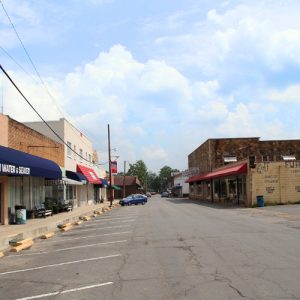 Clinton Street Scene
Clinton Street Scene 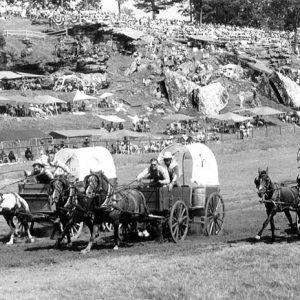 National Championship Chuckwagon Race
National Championship Chuckwagon Race 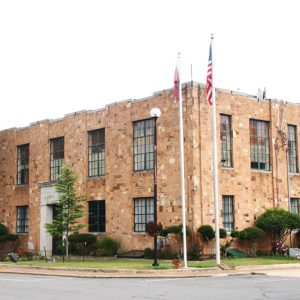 Van Buren County Courthouse
Van Buren County Courthouse 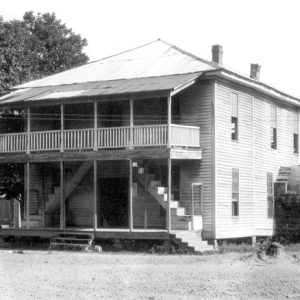 Van Buren County Courthouse
Van Buren County Courthouse 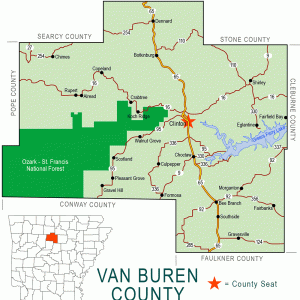 Van Buren County Map
Van Buren County Map 



I went to school in Clinton for one year, 195556. I was in 6th grade. The school was on top of a hill from my house. There were some woods by the school and a path through the woods to get downtown. What was the name of the school and is it still there? Also my dad was plant manager of the chicken plant out of town. There was a small bridge we drove over and a small creek we kids would play in while waiting for my dad to get off work. Did the creek have a name? Even though my family lived in Clinton for only a year, we kids havent forgot how pretty it was around there and all the mountains.